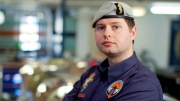
 Bloodhound SuperSonic Car (SSC) is the name of a UK project aiming to break the land speed record with a car powered by a jet engine and a hybrid rocket motor. The car has a design speed of 1,050 mph (1,609 km/h).
Bloodhound SuperSonic Car (SSC) is the name of a UK project aiming to break the land speed record with a car powered by a jet engine and a hybrid rocket motor. The car has a design speed of 1,050 mph (1,609 km/h).
Bloodhound SSC is being developed and built with the intention of breaking the land speed record by the largest ever margin to inspire future generations of schoolchildren into careers in Science, Technology, Engineering and Maths (STEM). Record attempts are aimed for late 2013 (850 mph) and 2014 (1,050 mph) on the Hakskeen Pan in South Africa, with run data being published on the internet for the student population to follow and download.
The Bloodhound SSC project is headed by Richard Noble OBE, former driver of Thrust 2, who broke the land speed record and achieved 633 mph in 1983. In 1997, RAF Wing Commander Andy Green set the current record at 763 mph in Thrust SSC, and he has joined Richard Noble once more for the Bloodhound Project.
At the end of 2011, Richard Noble approached the Royal Electrical & Mechanical Engineers (REME) to lease technical manpower, workshop equipment and deployable engineering facilities. The proposal was put to Major General Paul Jaques and the REME Corps Colonel and received unanimous support. However, the initiative required careful financial modelling and – more importantly – approval.
 Bloodhound Project Director, Richard Noble OBE
Bloodhound Project Director, Richard Noble OBEI was asked to staff the proposal through the Army financial chain along with a case setting out the benefits of involvement before it was sent to the Chief of the General Staff and then to the then Permanent Under Secretary (PUS) Ursula Brennan.
In considering the benefits of the REME’s involvement, I spoke with a wide range of interested parties in recruitment, training, procurement and scientific domains. I knew that the project would provide REME team members with ‘rocket powered’ professional development and benefit the field force by bringing cutting-edge knowledge and expertise back into the Army. The benefits, however, went much further…
The potential for Army Electrical and Mechanical engineers to engage with a young student population was unique. Using technology owned by every family to tell the story of science and engineering, we had the opportunity to inspire young people into STEM careers with the excitement and danger of the land speed record!
This meant that we could support the growth of future British scientists and engineers. Some may join the REME or REME Territorial Army, and others might consider the Civil Service as a potential career path, be it Defence Equipment & Support (DE&S) or the Defence Scientific & Technology Laboratory (DSTL).
 Outreach with schools to inspire the next generation of engineers
Outreach with schools to inspire the next generation of engineersEven if those individuals inspired into STEM careers did not consider the Defence sector, they will be able to make a contribution to the wider economy and support growing sectors such as the civil nuclear industry
After an uncomfortable wait, I received the news in May 2012 that the proposal had been agreed by Chief of the General Staff in consultation with PUS and a contract could be written by Army HQ’s Wider Markets team who specialise in requests by industry to lease Army resources. After another round of staffing, contract writing by the commercial staff (an excellent learning experience!) and lengthy negotiation, Army Headquarters signed a contract with Bloodhound SSC to supply technical services and equipment over a two-year period.
All I had to do now was find four REME technical experts for the first six-month work attachment…
 The Army’s Royal Electrical and Mechanical Engineers (REME) are amongst the world’s leading engineering and management organisations, supporting cutting-edge equipment and technology in the most challenging environments across the world |



